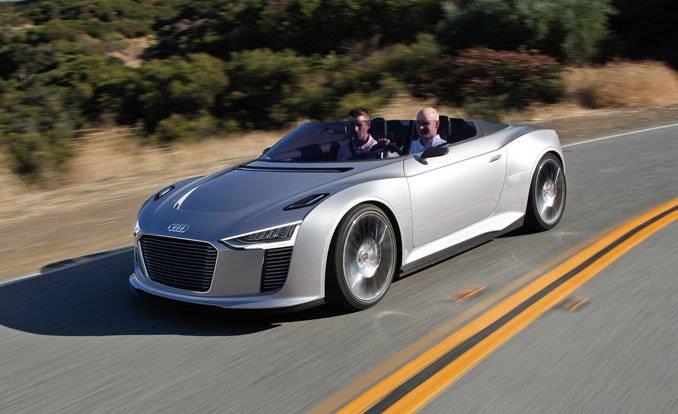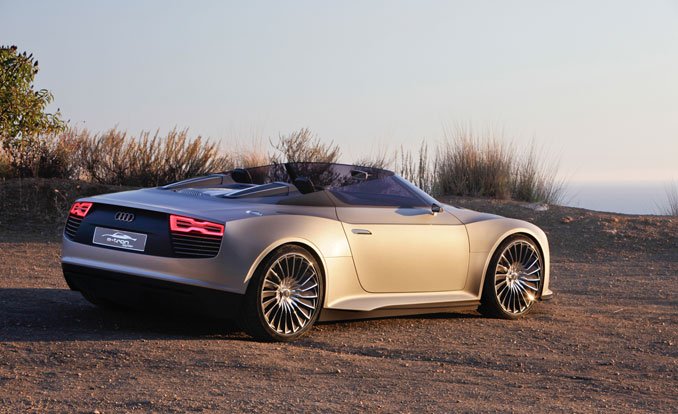

The cop is clearly pushing his Crown Victoria police interceptor, but he can’t lose us—his lights are flashing wildly; he pulls ahead on the straightaways, but we catch up in the corners. Several miles up Mulholland Highway northwest of Los Angeles, he’s had enough. The officer yanks his cruiser around and blocks the road. Our drive is over. But as we get out of the car, he flashes a big smile. This time, the law is on our side.
The police are here at Audi’s behest to secure the road and make sure our ride, the tangible offspring of a project worth between $6.5 million and $13 million, will remain unscathed by fellow motorists. The e-tron Spyder debuted at last year’s Paris auto show alongside the Quattro concept—which we’ve also driven. The Quattro is based on a shortened RS5 platform and powered by a 2.5-liter turbo, but the e-tron Spyder rides on a bespoke chassis that borrows only its rear suspension and brakes from another Audi, the R8. Far from being art for art’s sake, however, it showcases technical and stylistic approaches that could define future Audis.
Diesel and Electric (and Could Pull Like a Locomotive)
One of these ideas is demonstrated by the powertrain: The e-tron Spyder drives its rear wheels with a midship-mounted, twin-turbocharged diesel V-6 good for 300 hp and 480 lb-ft of torque. The front wheels are powered by a pair of electric motors that combine for 88 hp and 260 lb-ft. Audi is hopeful that, despite their extra weight, electric motors employed in this manner will make cars more agile, as they can apply torque with extreme precision and celerity.
On paper, the target weight of this prototype is 3197 pounds, and its transmission is a seven-speed dual-clutch. In reality, the e-tron Spyder weighs 3638 pounds and has a CVT. To avoid frying the rubber-band box, Audi has reduced the diesel’s torque to 280 lb-ft. Additionally, the car is limited to about 40 mph—the aluminum wheels with their carbon insets are, after all, one-off show pieces—which explains why the Crown Vic was working so hard. Even with such dramatic handicaps, the e-tron Spyder is rewarding. This sleek concept launches like a brute, the thrust accompanied by the deep growl of the diesel and the hiss of the turbochargers.


We also tried out electric operation, which was by no means sluggish but not nearly as impressive as diesel mode. Combined diesel and electric propulsion wasn’t an option. This is a concept car; that we were allowed to drive it at all is unusual. We loved it with the diesel alone and can only imagine how this car would scoot in theoretical production trim more than 400 pounds lighter, with the diesel at full power and the extra assistance of the torquey electric motors. Audi says it could do 0 to 62 mph in 4.4 seconds and reach a governed top speed of 155 mph. Why not?
If Only We Could Go Faster
The chassis matches the powertrain’s performance. It’s agile and neutral and remains entirely composed even during aggressive cornering in Mulholland’s tightest bends, where 40 mph is actually pushing it. The electric power steering is a bit too effortless, but again, this is a prototype—that some Teamster isn’t kneeling alongside it jerking the wheels back and forth to affect directional changes on the show stand is something of a novelty. As we exit the ultra-tight corners on Mulholland and push the accelerator, the vicious pull forward repeatedly plasters a smile on our faces.
Beyond the diesel-electric powertrain, the e-tron Spyder points the way to a possible mid-engined sports car positioned between the TT and R8. The elegant shape, penned by Wolfram Luchner (who is now at General Motors), is one of several ideas for an expansion of Audi’s lineup and stands among our favorites. We doubt, however, that cops will be all smiles if we ever encounter them in the real thing.